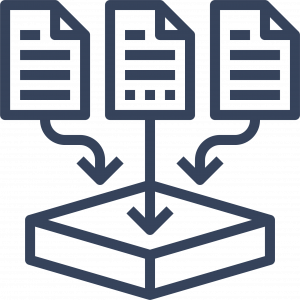Our vision for a new approach
to collaboration
Together for Rare Diseases (Together4RD), a multi-stakeholder group that encompasses representatives of the patient community, decision-makers, European Reference Networks (ERNs) and industry, is seeking to promote a rare diseases ecosystem in Europe that puts collaboration at its centre.
This collaborative ecosystem, with on a model for partnerships between ERNs and industry, would unlock the benefits of cooperation across the EU for rare diseases, in the areas of research, diagnosis and care for people living with a rare disease, whilst ensuring transparency and safeguarding public trust. Moreover, it would serve to promote the EU as a global leader in care and innovation in rare diseases.
We believe ERNs, as expert healthcare provider networks, have the potential to be the ‘engine of change’ for driving transformational change in how research is done and healthcare is delivered to meet the needs of people living with a rare disease: including for the 95% of rare diseases that still have no dedicated treatment options.
ERNs have access to a wealth of clinical and scientific expertise, as well as potential to collect and pool data from dispersed patient populations. The pharmaceutical industry also has its own, complementary, expertise in translational research, running clinical trials and interacting with regulatory authorities, whilst also possessing resources that are unavailable to clinical and research networks.
In sum, the skills and information that could unlock life-saving research, diagnosis and care rely upon partnership. To-date, collaborations between ERNs and industry have, despite their potential value, failed to materialise in any widespread, harmonised way.
Together4RD’s four recommendations call upon European decision makers to take decisive steps towards the future and be the drivers of the much-needed change in the European rare diseases landscape.
The challenge(s) we face
Currently, there is a lack of clarity on what collaborative activities are acceptable between ERNs and industry and how different activities should be delivered.
Concerns from some around (i) willingness to enhance participation in the ERN research agenda and what data should be collected, and (ii) the conditions under which companies can access this data, mean many ERNs have refrained from entering dialogues with commercial third parties (and indeed not deem such collaborations to be ‘ERN collaborations’). Practical challenges around contracting, data access, and the (lack of) status as legal entities for ERNs have been reported to compound the issue.
In 2019 the Board of Member States of ERNs (BoMS) published a Statement outlining its updated guidance for ERN-industry collaboration, but restrictions on funding and activities around registries make collaboration difficult and prevented discussions from progressing.
Creative and tangible solutions to the current barriers to partnership are needed to break the deadlock.
Proposed Policy Asks to foster collaboration

Recommendation 1
ERN Governance
Promote transparent governance structures and open dialogue to empower and advance ERN-industry collaboration
Building on the Rare 2030 Recommendation for ERNs to have clear rules for collaboration with industry in pre-defined areas, the Board of Member States should revise its guidance on ERN collaboration with industry, and thus update its 2019 Statement. The revised guidance should:
- Reflect the significant added value for research and development where ERN-industry collaborations take place (for example, using data accessible by ERNs to support therapies’ post-marketing authorisations);
- Consider the body of existing best practices for managing these partnerships in a transparent, ethical way, maintaining ERNs’ independence (ERN independence refers to the ability to carry out activities without influence of private partners, such as industry(namely, financial independence)); and
- Give appropriate governance guidelines, including roles, rules and checks and balances, to foster effective and transparent partnerships. A robust framework could provide contracting parties with the necessary legal clarity and security, and increase willingness for collaboration on both sides.
Tried and tested forms of contracting (developed with input from patients, clinicians, healthcare providers, and industry), which ERNs and commercial third parties can use to agree collaborations, should be promoted to speed up these discussions and empower ERNs to enter more dialogues with potential partners.
- These forms of contracting should recognise and adapt to the considerations and complexities associated with different intensities of exchange and collaboration that may be contemplated between ERNs (or healthcare providers) and commercial third parties.
- Governance structures and systems of checks and balances must be proportionate to the activities being undertaken.

Recommendation 2
Pre-clinical Public-Private Research Collaboration
Create a Forum (or Fora) for public-private exchange of pre-clinical knowledge
Create a Forum (or Fora) for exchange of pre-clinical knowledge between ERNs (as public actors) and industry partners (as private actors). This will ensure there are opportunities to better address rare diseases with no approved treatments, no clinical trials and no research underway because of the more limited understanding, as cross-fertilisation can support breakthroughs. Sub-Fora for individual ERNs may be envisaged and would be complementary to a broader Forum across all ERNs.
- This Forum/these Fora should link to existing initiatives and structures, such as the proposed Moonshot for Rare Diseases (EURORDIS and EFPIA have proposed a Moonshot for basic and translational research for adult and paediatric rare disease) and the clinical research networks envisaged under the European Rare Disease Partnership, so that its outputs are embedded within the rare disease ecosystem and act as a positive multiplier, driving research and innovation forward with ERNs centre-stage.
- This Forum/these Fora may benefit from the exchange with academic institutes which develop a part of pre-clinical knowledge.
- Proportionate governance structures should be used, recognising the reduced risks associated with public-private engagement in the pre-clinical stage of R&D.
- Together4RD, as a multi-stakeholder platform connecting the patient community, decision-makers, European Reference Networks (ERNs) and industry partners, would work with EU institutions and partners in the rare diseases space to support hosting of this Forum/Fora, ensuring they are anchored to the EU ecosystem, and promote exchange between ERNs and potential industry partners on a regular basis.

Recommendation 3
Independent, Well-Resourced and Effective ERN Registries
Ensure ERN registries are adequately financed via public funds and remain independent, whilst clarifying & optimizing their potential for collaboration
ERN registries need to build viability in the long term, and operate in a diverse and sustainable business model, including:
- to (i) ensure they sustain the harmonised core infrastructure for the new ERN-wide registries, (ii) embed appropriate data standards and abide by FAIR data principles, and (iii) remain independent and free from conflicts of interest that could arise from collaboration with commercial third parties.
- Member States should be encouraged to financially support their local sites to have capacity to input data, resolving resourcing issues around updating registries (Together4RD welcomes the forthcoming Joint Action on ERN integration into national health systems, which will offer recommendations for national support systems for local site work on registries.). The development of National Rare Diseases Plans would be beneficial for this purpose, as well as encouraging the involvement of national Healthcare Providers in ERNs.
- As resources are shown to be insufficient, private funding should be incorporated to the registry ecosystem. The areas where private funding can be incorporated should be further discussed among stakeholders. It could include, for example (with appropriate caveats) (i) supporting the federation of disease-specific registries pre-dating ERNs (or operating outside of ERNs), including the ones developed by industry with the newer ERN-wide registries, and (ii) developing more comprehensive ‘sub-registries’ or new (co-owned or independent) registries, to capture rich data for advancing knowledge and stimulating new research (particularly if such data is intended to serve regulatory purposes). ERICA Work Package 2 is developing a white paper on data management strategy for rare disease registries. It will contain recommendations to support a data strategy for ERNs, which Together4RD believes should be accommodate increased third party collaboration.
- Common rules should be agreed for ERN registries around data ownership, access approvals and conditions for use by third parties. These rules must be developed with input from all relevant stakeholders, including clinicians, healthcare providers, patients, and industry, and should be premised on the principles of non-exclusivity and FAIR. FAIR data is data that meets the principles of findability, accessibility, interoperability, and reusability.
Where possible, there should be aligned quality standards across registries. Multi-stakeholder engagement is required for developing data dictionaries, to increase the quality and relevance of registry data and allow it to serve a range of research and regulatory-oriented purposes.
The European Health Data Space must allow for transparent and compliant secondary use of health data by third parties for research purposes, including in the context of ERN-industry collaboration, to introduce EU-level standards on health data collection and promote interoperability across national borders and full respect for data ownership.

Recommendation 4
EU Rare Disease Action Plan
Create a comprehensive European Action Plan for Rare Diseases that supports public-private partnerships
Together4RD supports calls for a dedicated EU Action Plan for Rare Diseases (the ‘Action Plan’) to be put in place by the European Commission, with a clear vision for the future rare disease ecosystem in Europe. The Action Plan was called for by MEPs in 2021, and is now being developed by the Czech Presidency of the EU Council.
To support ERN-industry collaboration, which is an important pillar of a future rare disease ecosystem, the Action Plan should both:
- Establish a framework that supports, broadly, more public-private partnerships in the rare disease ecosystem, including (but not limited to) ERNs; and
- Set out a clear strategy for the future of ERNs in the EU rare disease ecosystem, including encouraging and supporting ERN collaboration with industry to support innovation in R&D.
The Action Plan will need to embed a comprehensive monitoring and evaluation mechanism across all its ambitions. One of these indicators could consider the number of public-private collaborations that have been realised, to deliver on the ambition of Europe being a global innovation hub and revolutionising research, diagnosis and care for those living with rare diseases.